Castor meal/castor residue
Castor meal - the residue obtained from castor cake - is one of the most versatile natural manures.
It serves as organic manure that enhances the fertility of the soil without causing any damage or decay. It is enriched with the three big elements which will be vital and conducive to the proper growth of crops - Nitrogen, Phosphorus and Potassium. It also has traces of nutrients like Manganese, Zinc and Copper, thus making it a balanced fertiliser.
Advantages
1. Provides all the major & minor nutrients necessary for better plant growth
2. Helps in increasing the nutrient uptake by plants
3. Improves soil fertility and productivity; improves yield & quality of the farm produce
4. Protects plants from nematodes and termites
Main Uses of Castor Meal
The two primary uses of castor meal today are as fertilizer and as fuel
Benefits of castor cake as a soil fertilizer:
· Increasing yield
· Improving soil P indices
· Increasing cane yield and sucrose content in juice
· Increasing N content in grain and straw
· Controlling nematodes
· Increasing tuber yield
Plants best fertilized by castor de-oiled cake:
Maize, Sugarcane, Rice, Banana, Jute, Tomato, Wheat/Barley, Potato and Tobacco
Castor Meal Composition
Nutrient Content of Deoiled Castor Cake / Meal
A typical composition of castor residue/meal is as follows:
Organic Matter 80-85% (The organic matter consists of proteins about 32-33%, fibers about 25-30%, ash content – about 6%)
|
Nitrogen |
5% |
|
Phosphorus (as P205) |
2% |
|
Potassium |
1.25% - 1.5% |
|
Moisture |
10% max. approx. |
|
Oil Content |
0.7% max. approx. |
It also contains some micro nutrients viz., Calcium, Magnesium, Sulphur, Iron, Zinc, Manganese, Copper etc.
Castor meal is an excellent fertilizer because of high content of N (6.4%), Phosphoric Acid (2.55%), Potash (1%) and moisture retention.
The protein content of castor seed meal varies between 21-48% depending upon the extent of decortications. It has an ideal amino acid profile with moderately high cystine, mithionine, and isoleucine.
While it is rich in proteins, castor cake cannot be used as cattle fodder because of its toxicity.
Energy Content in Castor meal:
The calorific value of deoiled castor cake is about 4200 Kcal per kg. Given the fact that the cost of castor meal/cake is lower than those of other equivalents such as soy meal, rapeseed meal etc., and given its reasonably good energy content, castor meal is today used in some cases as a cost effective fuel. However, the limited quantities in which castor meal is available, and the significant demand that emanates for its use as organic fertilizer implies that the impact of castor meal on the biomass/biofuels industry is insignificant.
Toxicity in Castor meal:
The castor cake is mainly used as a fertilizer. It is unsuitable as an animal feed because of the presence of toxic protein called ricin and toxic allergen often referred to as CBA (castor bean allergen). However, it is noteworthy that none of the toxic components is carried into the oil.
Some methods for the detoxification of the cake have been attempted. These include Treatment with ammonia, caustic soda, lime and heat.
When the cake is steamed, the ricin is detoxified and the allergen is inactivated.
Another method of detoxifying castor seed meal involved the wet mixing with sal seed meal so that the toxic constituents of castor seed were neutralized by tannins.








